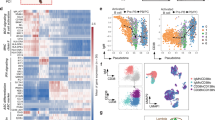Abstract
Fusion of lymphoblastoid cell lines that produce human monoclonal antibodies against Pseudomonas aeruginosa with the human/mouse heteromyeloma SHM-D33 generated heterohybrids that were stable and secreted antibody in the range of 20 to 300 μg/ml. One of the hybridoma cell lines was adapted to serum-free medium and maintained for 60 days in an automated hollow fiber system. During that time, 3 g of antibody was produced. Such yields make it possible to evaluate these monoclonals for their therapeutic potential in patients at risk for Pseudomonas infections.
Similar content being viewed by others
References
Andersen BC and Gruenberg ML (1987) Optimization techniques for the production of monoclonal antibodies utilizing hollow fiber technology. In: Seaver S (ed.) Commercial Production of Monoclonal Antibodies pp. 175–195. Marcel Dekker Publishing Co., New York.
Atlaw T, Kozbor D and Roder JC (1985) Human monoclonal antibodies against Mycobacterium leprae. Infect. Immun. 49: 104–110.
Brokopp CD and Farmer III JJ (1979) Typing methods for Pseudomonas aeruginosa. In: Doggett RG (ed.) Pseudomonas aeruginosa, Clinical Manifestations of Infection and Current Therapy, pp. 89–113. Academic Press, New York.
Carroll WL, Thielemans K, Dilley J and Levy R (1986) Mouse x human heterohybridomas as fusion partners with human B cell tumors. J. Immunol. Methods 89: 61–72.
Darveau RP and Hancock REO (1983) Procedure for isolation of bacterial lipopolysaccharides from both rough and smooth Pseudomonas aeruginosa and Salmonella typhimurium strains. J. Bacteriol. 155: 831–838.
Finney DJ (1971) Probit Analysis, pp. 39–104. Cambridge University Press, 3rd edition.
Foung SKH, Perkins S, Raubitschek A, Larrick J, Lizak G, Fishwild D, Engleman EG and Grumet FC (1984) Rescue of human monoclonal antibody production from an EBV-transformed B cell line by fusion to a human-mouse hybridoma. J. Immunol. Methods 70: 83–90.
Hirschel MD and Gruenberg ML (1987) An automated hollow fiber system for the large scale manufacture of mammalian cell secreted product. In: Lydersen BK (ed.) Large Scale Cell Culture Technology, pp. 113–144. Hanser Publishers, New York.
James K and Bell GT (1987) Human monoclonal antibody production. Current status and future prospects. J. Immunol. Methods 100: 5–40.
Kozbor D and Roder JC (1983) Monoclonal antibodies produced by human lymphocytes. Immunol. Today 4: 72–79.
Laemmli UK (1970) Cleavage of structural proteins during the assembly of the head of bacteriophage T4. Nature 227: 680–685.
Larrick JW and Bourla JM (1986) Prospects for the therapeutic use of human monoclonal antibodies. J. Biol. Response Modif. 5: 379–393.
Mantel N and Haenszel WJ (1959) Statistical aspects of the analysis of data from retrospective studies of disease. J. Natl. Cancer Inst. 22: 719–748.
Oi VT and Morrison SL (1986) Chimeric antibodies. Bio-Techniques 4: 214–221.
Riechmann L, Clark M, Waldmann H and Winter G (1988) Reshaping human antibodies for therapy. Nature 332: 323–327.
Scher I (1982) The CBA/N mouse strain: An experimental model illustrating the influence of the X-chromosome on immunity. Adv. Immunol. 33, 1–71.
Teng NNH, Lam KS, Riera FC and Kaplan HS (1983) Construction and testing of mouse-human heteromyelomas for human monoclonal antibody production. Proc. Natl. Acad. Sci. USA 80: 7308–7312.
Thompson KM, Melamed MD, Eagle K, Gorick BD, Gibson T, Holburn AM and Hughes-Jones NC (1986) Production of human monoclonal IgG and IgM antibodies with anti-D (rhesus) specificity using heterohybridomas. Immunology 58: 157–160.
Verhoeyen M, Milstein C and Winter G (1988) Reshaping human antibodies: Grafting an antilysozyme activity. Science 239: 1534–1536.
Zweerink HJ, Gammon MC, Hutchison CF, Jackson JJ, Pier GP, Puckett JM, Sewell TJ, and Sigal NH (1988a) X-linked immunodeficient (xid) mice as a model to test protective efficacy of monoclonal antibodies against Pseudomonas aeruginosa. Infect. Immun. 56: 1209–1214.
Zweerink HJ, Gammon MC, Hutchison CF, Jackson JJ, Lombardo DL, Miner KM, Puckett JM, Sewell TJ and Sigal NH (1988b) Human monoclonal antibodies that protect mice against challenge with Pseudomonas aeruginosa. Infect. Immun. 56: 1873–1879.
Author information
Authors and Affiliations
Rights and permissions
About this article
Cite this article
Gammon, M.C., Banas, M.H., Boccumini, L.E. et al. Heterohybridomas that secrete high levels of pseudomonas-specific therapeutic human monoclonal antibodies: their generation and large scale growth in an automated hollow fiber cell culture system. Cytotechnology 3, 51–60 (1990). https://doi.org/10.1007/BF00365266
Received:
Accepted:
Issue Date:
DOI: https://doi.org/10.1007/BF00365266




